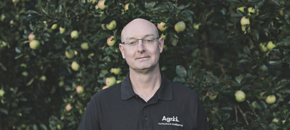
Conversion Therapy in Cambridgeshire
News - 01.03.22
A long-term trial exploring a more regenerative approach to farming a difficult Hanslope series clay at Midloe Grange, Southoe just off the AI near St Neots.
Spring barley yields were well down in the first year of Cambridgeshire grower, David Felce’s long-term trial exploring a more regenerative approach to farming his difficult Hanslope series clay at Midloe Grange, Southoe just off the AI near St Neots.
But then so too were cultivation costs and working time. And Agrii Soil Resilience Strategy (SRS) assessments going into the second planting season suggest worthwhile improvements in the health of the ground that bode well for the future.
The key question, though, is the extent to which these gains will offset any reduction in income from the change.
For himself and as part of his Green Horizons iFarm demonstration work with Agrii, David has been keen to gain first-hand experience of the practicalities and consequences of converting his long-established and well-understood heavy land farming practice to one involving the least possible tillage and greatest use of cover crops.
He is doing this in a 10ha field coming out of OSR and going into two years of spring barley as part of his determined black-grass management strategy. On one half of Great Sheepwalk he is maintaining his conventional regime while moving to a more regenerative one on the other.
“Over the years we’ve developed an approach that makes the most of the generally low organic matter ground which does not have the benefit of grazing livestock,” he explains. “And, like many, we’ve adapted this to deal with serious black-grass problems.
“Spring barley here has always responded well to a decent autumn cultivation – with the plough where necessary – weathering down over the winter, spraying-off and drilling without further cultivation as soon as conditions allow in the spring.
“Even though direct drilling and cover cropping can be a tough ask on heavy land with a significant silt content like ours that has always benefited from metal at depth, we were keen to see if this approach could help us improve our soils and their sustainability. Having said that, of course, our first key to being sustainable has to be to stay in business.
“The difficult autumn of 2020 prevented us getting our planned cover crop in after the rape. Instead, on the ‘conversion’ side of the field we had to content ourselves with what turned out to be a decent cover of OSR volunteers in an uncultivated stubble. We sprayed this off well in advance of strip drill drilling the barley last spring.
“Thankfully, much better conditions allowed us to establish a good cover mix of black beans, black oats, phacelia and vetch this past autumn, drilled behind the low disturbance legs of the mounted seeder we have built with Will Mumford of Vantage England & Wales and Tom Carnell of Tramline Tec. And this profited from the mild winter to develop an excellent canopy which we again sprayed-off well ahead of barley drilling.
“After its second spring barley, we’re planning to put the field back into a winter crop – either winter barley and then OSR, or beans, followed by wheat, winter barley and OSR to give a wider rotation. In each case we will be following our established practice on one side and a least tillage approach on the other, assessing soil conditions regularly as well as fully costing crop performance.”
So what has the first year and a half of the conversion trial shown?
Well, as many have found when making a similar shift, yields were definitely compromised.
In a poor season for spring barley locally, the conventional Midloe Grange crop averaged 4.74t/ha while the more regenerative one did just 3.68t/ha – a gross output difference of £200/ha for the business.
However, cultivation costs at standard National Association of Agricultural Contractors (NAAC) rates were also much lower at just under £79/ha against £237/ha.
This brought the difference between the two regimes down to only £42/ha in margin over establishment cost terms.
“Our more detailed comparisons with tillage specialist, Phillip Wright also showed a time saving of over 1.5 hours/ha on the conversion side,” adds Mr Felce.
“The value of the time saved, of course, entirely depends on individual conditions and workload pressures. This could be very significant over a much larger area of cropping than our 90ha and with the tight weather windows we so often have these days.”
Encouragingly too, the SRS assessments undertaken across the field last December showed noticeable across-the-board improvements in soil condition, especially infiltration rate.
“Actually, the superb autumn we’ve had this time round meant both halves of the field went into the spring looking in equally good condition,” Mr Felce observes. “So, it will be interesting to see how they perform at harvest. Especially so, if the season ‘strikes back’ as most seem to have done at some stage lately.
How to capitalise on soil improvements:
“Our key dilemma at this stage is how best to capitalise on the soil improvements we are making. We know the ground under conventional regime will drill well with either the mounted Kvernland TS or the trailed Vaderstad Rapid we have access to. At the same time, we also know that neither of these drills would work well with the amount of trash and fluffiness of the topsoil we have under our new regime.
“What we probably need to get the barley in accurately at an even depth with minimal soil disturbance to retain moisture and avoid waking black-grass is a purpose-built, disc-based piece of kit like the Kuhn Auroch. But they cost of over £100,000 and would require 100hp more than our present drills to operate. Thankfully, we have a neighbour to do this on contract for us. Even so, it could well have consequences for our headlands.
“This is just highlighting some of the extra things we need to bear in mind as part of our conversion journey. Reducing tillage is nowhere near as simple a sustainability solution as it can appear at first sight and it will take time to get things right.
“The big worry with a regime we cannot possibly understand half as well as the tried and tested one we’ve been using for the past 20 years is that getting things wrong could easily undo any progress and leave ourselves much worse off. Which we simply cannot afford.”
Join Our Community

Agrii X
We love engaging with clients and partners. Give us a follow and let's share stories for the community.

Agrii Instagram
A picture paints a thousand words. Follow us on Instagram to see what we are up to.

Agrii LinkedIn
If you are all about the business, connect with us on LinkedIn to build your network



